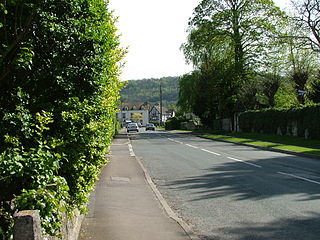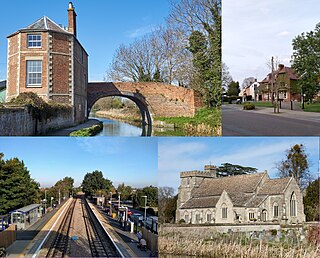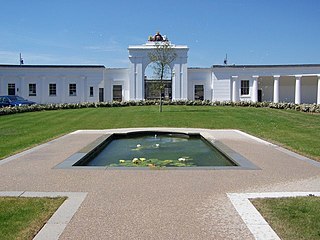
The River Thurne is a river in Norfolk, England in The Broads. Just 7 miles (11 km) long, it rises 2 miles (3.2 km) from the coast near Martham Broad and is navigable from West Somerton. It flows southwest and is linked by Candle Dyke and Heigham Sound to both Horsey Mere and Hickling Broad. It continues southwest and flows through Potter Heigham and enters the River Bure just south of Thurne dyke, near St Benet's Abbey.

Stroud is a market town and civil parish in Gloucestershire, England. It is the main town in Stroud District. The town's population was 13,500 in 2021.

Stroud District is a local government district in Gloucestershire, England. The district is named after its largest town of Stroud. The council is based at Ebley Mill in Cainscross. The district also includes the towns of Berkeley, Dursley, Nailsworth, Stonehouse and Wotton-under-Edge, along with numerous villages and surrounding rural areas. Over half of the district lies within the Cotswolds Area of Outstanding Natural Beauty.

Abbey Mills Pumping Station is a sewage pumping station in Mill Meads, East London, operated by Thames Water. The pumping station lifts sewage from the London sewerage system into the Northern Outfall Sewer and the Lee Tunnel, which both run to Beckton Sewage Treatment Works.

King's Stanley is a civil parish and village in Gloucestershire, England, to the south of Stonehouse and southwest of the town of Stroud.

Stonehouse is a town in the Stroud District of Gloucestershire in southwestern England.

The River Frome, once also known as the Stroudwater, is a small river in Gloucestershire, England. It is to be distinguished from another River Frome in Gloucestershire, the Bristol Frome, and the nearby River Frome, Herefordshire. The river is approximately 25 miles (40 km) long.

Stowell Park Estate is a 6,000-acre (24 km2) historic agricultural and sporting estate in the Cotswold Hills, Gloucestershire, England. The estate includes the village of Yanworth. The main house is a Grade II* listed building and surrounded by extensive parkland, a mill, and church. The landscaped park is listed Grade II on the Register of Historic Parks and Gardens.

Darley Abbey is a former historic mill village, now a suburb of the city of Derby, England. It is located approximately 1.4 miles (2.3 km) north of the city centre, on the west bank of the River Derwent, and forms part of the Darley ward along with Little Chester and the West End. The settlement dates back to the medieval era, when it was the site of an Augustinian monastery. In the 18th century, the Evans family developed their planned industrial mill village in the area; Darley Abbey is now part of the Derwent Valley Mills World Heritage Site.

The Leeds Industrial Museum at Armley Mills is a museum of industrial heritage located in Armley, near Leeds, in West Yorkshire, Northern England. The museum includes collections of textile machinery, railway equipment and heavy engineering amongst others.
Sir Philip Sidney Stott, 1st Baronet, usually known by his full name or as Sidney Stott, was an English architect, civil engineer and surveyor.

Ryeford railway station served the villages of Ryeford, King's Stanley and Leonard Stanley in Gloucestershire, England. It was on the 5.8-mile (9.3 km) Stonehouse and Nailsworth Railway, later part of the Midland Railway.

White Mill is a smock mill west of Sandwich, Kent, England that was built in 1760. The mill has been restored and is open to the public as part of the White Mill Rural Heritage Centre. The museum also includes the miller's cottage, which has been furnished to appear as it did between 1900 and 1939. Other displays in the outbuildings include farming and craft tools, wheelwright and blacksmith workshops.

Sir Richard Arkwright's Masson Mill is a water-powered cotton spinning mill situated on the west bank of the River Derwent in Matlock Bath, Derbyshire in England. This mill was built in 1783. It forms part of the Derwent Valley Mills, a World Heritage Site. Nearby is Willersley Castle, the house Richard Arkwright built for himself within the parish of Matlock.

Leonard Stanley, or Stanley St.Leonard, is a village and parish in Gloucestershire, England, 95 miles (150 km) west of London and 3.5 miles (5.5 km) southwest of the town of Stroud. Situated beneath the Cotswold escarpment overlooking the Severn Vale, the surrounding land is mainly given over to agricultural use. The village is made up of some 600 houses and has an estimated population of 1,545 as of 2019. The hamlet of Stanley Downton lies less than a mile to the north and lies within the parish. In 1970, the village was twinned with the commune of Dozulé in the Calvados region of Normandy, northern France.
Stud Lodge is a building in the grounds of Eaton Hall, Cheshire, England. It is recorded in the National Heritage List for England as a designated Grade II listed building.

Queen Street Mill is a former weaving mill in Harle Syke, a suburb to the north-east of Burnley, Lancashire, that is a Grade I listed building. It now operates as a museum and cafe. Currently open for public tours between April and November. Over winter the café is opened on Wednesdays. It is also viewable with private bookings.

Royal Clarence Yard in Gosport, Hampshire, England was established in 1828 as one of the Royal Navy's two principal, purpose-built, provincial victualling establishments. It was designed by George Ledwell Taylor, Civil Architect to the Navy Board and named after the then Duke of Clarence. The new victualling yard was developed on approximately 20 hectares of land, some of which was already in use as a brewing establishment at Weevil on the west shore of Portsmouth Harbour, to the north of Gosport.

Painswick Stream is a small river in Gloucestershire, England. It is a tributary of the River Frome, and flows generally southwards, passing around the village of Painswick and through the town of Stroud. It used to join the Frome at its mouth, but was diverted into the then-derelict Stroudwater Navigation as part of a flood relief scheme in the 1950s. Despite its small size, it has been used to power a significant number of mills, many of which were associated with cloth manufacture until the industry was hit by a series of depressions in the 1820s and 1830s. Some found other uses, being used for grinding corn and for the manufacture of walking sticks and umbrella sticks, another prominent local industry. Many were subsequently demolished, but a number survive which have been granted listed building status.

Nailsworth Stream is a small river in Gloucestershire, England. It is a tributary of the River Frome. From its source near Cherington, it flows westwards through Avening to reach Nailsworth, where it turns towards the north, and passes through Woodchester to join the Frome at Dudbridge, a suburb of Stroud.


















